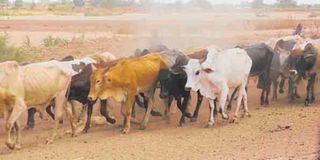Commercialization key for livestock sector

What you need to know:
- Commercialization of the livestock sector will improve productivity and increase income to the herders and the national economy
Arusha. Livestock keeping in Tanzania has to be commercialized in order to make it contribute significantly to the national economy.
Despite having the third largest population of livestock in Africa, livestock activities contribute only 7.4 per cent of the country's Gross Domestic Product (GDP).
Until recently, the annual growth rate of the sector remained as low as at 2.2 per cent despite increasing number of animals with little productivity gains.
"It is the responsibility of the experts to reach out the herders so as to reverse the trend", Prof Dominic Kambarage, the chairman of the Tanzania Veterinary Association (TVA) said.
Speaking at the association's annual general meeting, the don said traditional livestock keeping would neither improve the livelihoods of the herders and the economy.
He added the sector was key for the industrialization drive through the processing of livestock products such as milk, meat and hides and skins.
Tanzania has about 30 million cattle, 98 per cent of them of indigenous breeds, complemented by complemented by 16.7 million goats, 8 million sheep, 2.4 million pigs and 36 million chickens
"We have a great potential but not fully tapped due to failure to embrace modern animal husbandry practices", he said, challenging the experts to spearhead the change.
Currently agro-pastoralists households account for per cent of livestock production,pastoral communities 14 per cent and remaining six per cent comes from the commercial ranches and dairy sector.
A senior official in the ministry of Livestock Development and Fisheries Dr.Bedan Masuruli said the sector is also constrained by high disease prevalence.
He called for elaborate strategies to contain the diseases so as to lower the mortality rates and improve livestock reproductive rates.
He said the economy would benefit through the export of livestock but was concerned the quality of the country's animals could not meet the phytosanitary requirements of the foreign markets.
Opening the conference, the permanent secretary in the ministry Pof. Elisante Ole Gabriel said the livestock training institutions should also support on-going efforts to revamp the sector.
Livestock products in Tanzania include 2.4 billion litres of milk a year although the per capital milk consumption remains as low as 47 litres a year.
The 2.4 billion litres is sourced largely from the 1.5 million dairy cattle with the 27 million plus traditional herds producing only a fraction of that.
In 2015, Tanzania is also producing about 3.1 million hides and 2.8 million and 550,000 goat and sheep skins respectively a year valued at Sh. 33 billion then.




